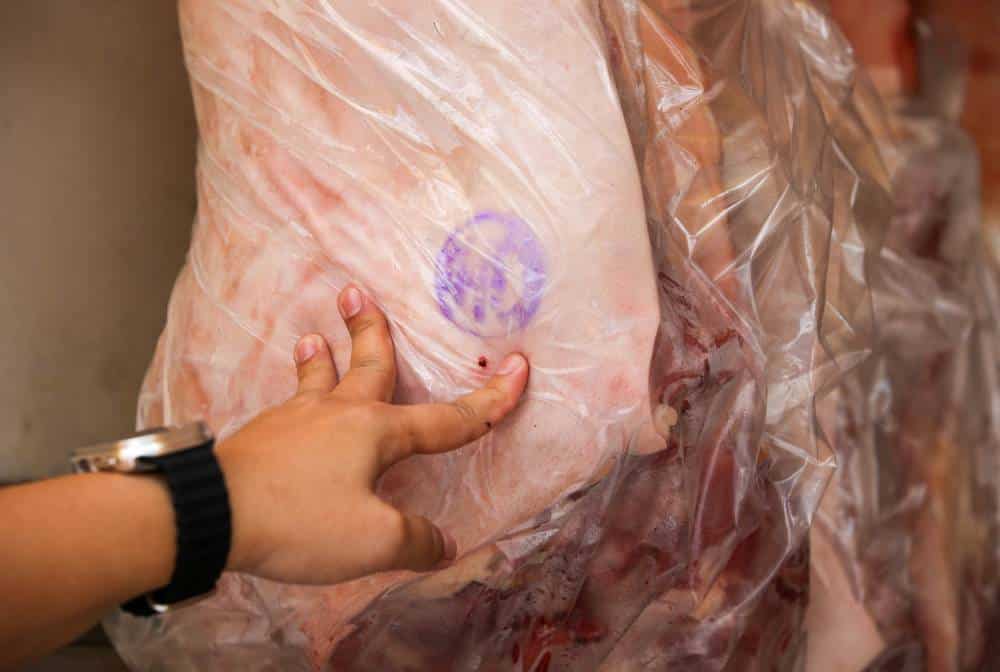
FILE PHOTO: Staff from the City Veterinary Office (CVO) of Marikina City Meat Inspection Unit inspect freshly slaughtered carcass inside a delivery van that just arrived at their Single Port Entry site on August 15, 2024. All meat products must pass through checking here before delivery in public markets, supermarkets, restaurants, other sellers in the city. The CVO requires the meat delivery trucks to also be registered with them and in good working condition. Carcass hung from the hooks must also have plastic wrapping at the end to prevent blood from dripping to the floors and to minimize contamination as these are loaded and taken from the vehicles, especially with the problem of African swine fever (ASF). Marikina has no slaughterhouses and gets supplies from Antipolo City, Quezon City, Rizal, Bulacan, and Tarlac provinces. INQUIRER /LYN RILLON
The volume of shipments of meat products bound for the Philippines in the 10 months up to October was already near the total for 2023 amid the retention of lowered import duties and the prevalence of animal diseases that threaten local output.
Data from the Bureau of Animal Industry (BAI) logged meat imports at 1.19 billion kilograms (kg) in the January-October period, equivalent to 98.9 percent of the 2023 import volume of 1.2 billion kg.
The 10-month volume was 16.8 percent higher than the 1.02 billion kg recorded in the same period a year ago.
READ: Processors appeal to halt buffalo meat importation ban from India
The Meat Importers and Traders Association (Mita) said meat imports are poised to hit last year’s volume despite the volatility of the exchange rate.
“With imports still arriving as seen from the utilization rate of the container yards and the slow rate of return of empties, the importers will take stock of the remaining inventory after the Christmas sales and hope the market will remain exuberant,” Mita president emeritus Jesus Cham said over the weekend.
Pork is king
Among the varieties of meat, pork accounted for half, or 50.2 percent, of overall imports. Chicken came second with a share of 32.7 percent, while beef was a distant third with 14.1 percent.
The country’s pork imports stood at 598.28 million kg, rising by 18.6 percent from 504.31 million kg. Traders purchased primarily pork cuts and offals.
“Ostensibly, ASF (African swine fever) continues to impact local pork production while the lower duty on pork meat is making offal less attractive relative to meat,” Cham said.
Imported chicken inched up by 8.6 percent to 389.95 million kg from 359.23 million kg. Those mechanically separated, used in manufacturing hotdogs, patties and sausages, were the most widely purchased type of chicken.
Beef imports surged the most among the three major meat varieties, climbing by 38.9 percent to 167.55 million kg from 120.64 million kg, mainly beef cuts.
Cham said the markets are more appreciative of the value of this red meat; hence, the double-digit growth.
Nearly half of shipments came from Brazil, the leading source of imported meat products, with 420.36 million kg, mainly pork and chicken. The United States followed with 179.56 million kg and Spain with 146.31 million kg.
The latest BAI data is somewhat aligned with the recent estimate of the United Nations’ Food and Agriculture Organization (FAO), which pegged this country’s meat import volume at 1.17 million metric tons this year.
“Similarly, in the Philippines, the extension of lower tariff rates on key meat products, aiming to mitigate rising meat prices, which will be applied until 2028, is likely to induce more purchases,” the FAO’s Meat Market Review said.
“In the Philippines, continued challenges related to animal diseases are expected to constrain domestic supplies, resulting in higher import demand,” it added.
ASF and avian influenza are still prevalent in the archipelago. The BAI recorded active ASF cases in 18 provinces in seven regions as of Nov. 22, while two provinces in two regions have active bird flu cases as of Dec. 6. INQ

